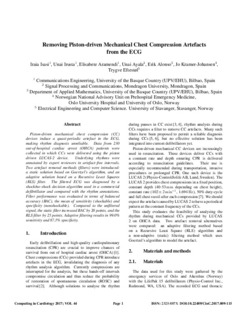Título
Removing piston-driven mechanical chest compression artefacts from the ECGAutor-a
Autor-a (de otra institución)
Otras instituciones
Universidad del País Vasco/Euskal Herriko Unibertsitatea (UPV/EHU)Norwegian National Advisory Unit on Prehospital Emergency Medicine
Oslo University Hospital
University of Oslo
University of Stavanger
Versión
Version publicada
Derechos
© 2017 The AuthorsAcceso
Acceso abiertoVersión del editor
http://dx.doi.org/10.22489/CinC.2017.009-115Publicado en
44th Computing in Cardiology Conference, CinC 2017. Rennes, France. 24-27 September. Computing in Cardiology Vol. 44. Pp. 1-4. IEEE Computer Society, 2017Editor
CinC Computing In CardiologyResumen
Piston-driven mechanical chest compression (CC) devices induce a quasi-periodic artefact in the ECG, making rhythm diagnosis unreliable. Data from 230 out-of-hospital cardiac arrest (OHCA) patients we ... [+]
Piston-driven mechanical chest compression (CC) devices induce a quasi-periodic artefact in the ECG, making rhythm diagnosis unreliable. Data from 230 out-of-hospital cardiac arrest (OHCA) patients were collected in which CCs were delivered using the piston driven LUCAS-2 device. Underlying rhythms were annotated by expert reviewers in artefact-free intervals. Two artefact removal methods (filters) were introduced: a static solution based on Goertzel’s algorithm, and an adaptive solution based on a Recursive Least Squares (RLS) filter. The filtered ECG was diagnosed by a shock/no-shock decision algorithm used in a commercial defibrillator and compared with the rhythm annotations. Filter performance was evaluated in terms of balanced accuracy (BAC), the mean of sensitivity (shockable) and specificity (nonshockable). Compared to the unfiltered signal, the static filter increased BAC by 20 points, and the RLS filter by 25 points. Adaptive filtering results in 99.0% sensitivity and 87.3% specificity. [-]
Colecciones
- Congresos - Ingeniería [423]
El ítem tiene asociados los siguientes ficheros de licencia:






















